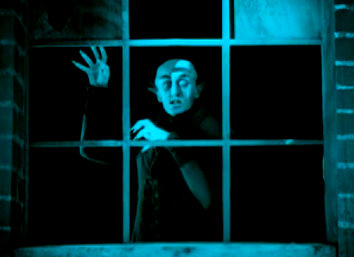Some Halloween ideas for fans of the great German expressionist monsters:
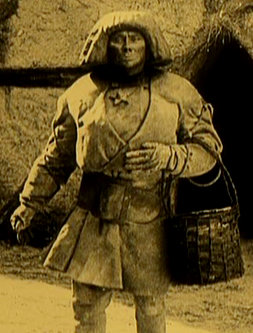 |
Golem with trick-or-treat basket. The Golem costume can be easily assembled by borrowing skirt, blouse, pentagram, and very wide belt from mom and thoroughly scrubbing them with a mixture of clay and water. Leave overnight to harden. Workboots and wig are essential and should be treated similarly.
Count Graf Orlok. It requires some advanced makeup technique to transform a typical human face into the rat-like visage of Nosferatu‘s vampire. Start with a normal zombie pancake foundation (white or grey) and embellish with excessive eyeliner, clip-on Spock ears, a bald cap, and rat teeth. A Matrix-style trenchcoat, preferably dusty from long storage in the attic, can suffice for the costume.

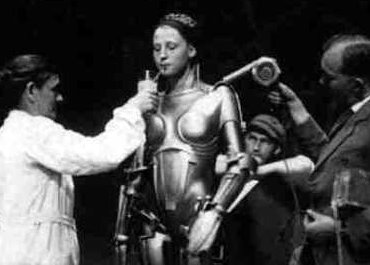
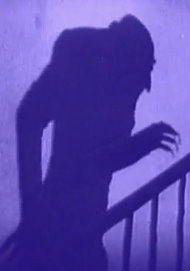
German expressionist monsters are great. They dominate their movies, leaving the other performers in the dust. Three particularly memorable monsters are played by Conrad Veidt in The Cabinet of Dr. Caligari (1919), Max Schreck in Nosferatu (1922), and Paul Wegener in The Golem (1920). From these three movies, Werner Krauss in Caligari is the only actor to offer the monsters any acting competition, and he does it through a prototype mad scientist role. To this list, I could add Brigitte Helm as the memorable false Maria in Metropolis (1927). She receives admirable support from its mad scientist character, played by Rudolf Klein-Rogge, but no one else is having any acting fun in the futuristic city. Good means dull in this world, and even Brigitte Helm bores when she’s the nice Maria.
This isn’t always the case with monster movies. Many are spiced with memorable supporting performances. In classic Universal horror movies like The Old Dark House (1932) and The Invisible Man (1933), director James Whale populated his landscapes with whimsical character actors happily chewing the scenery. But that’s not the case in most German expressionist horror films where the majority of the actors broadly play their roles, often resorting to the stock clichés of the silent era. And (although it may be shallow of me to point this out) the leads don’t even compensate for their lack of acting skills by being attractive. Sorry, but Florian and Miriam in The Golem are a singularly unattractive couple (although I’ll grant Miriam that Florian may start to look attractive when his only competition is Famulus!). Similarly, when watching Nosferatu, I’ve never located the supposed charms that compel Orlok to stay with Ellen Hutter till the cock crows.
But the monsters… they are to die for.
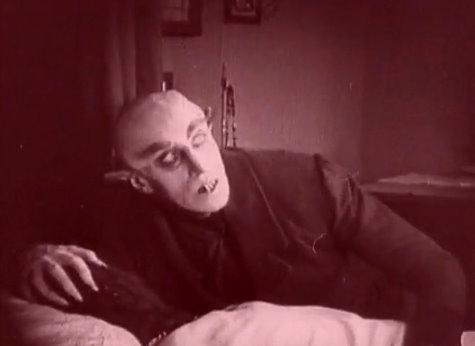
Paul Wegener’s performance as the Golem is inspired. There truly is something otherworldly about him—that makes him seem more animate clay than living man. When he first awakens, and the camera gazes at him in closeup as he slowly looks around the room, he appears to be a genuinely newborn being, seeing the world for the very first time.
Wegener’s swaying walk emphasizes his sheer bulk, making him appear both monstrous (in size) and childlike (in clumsy gait) at the same time. When Famulus takes the Golem out on a shopping trip, Wegener has the Golem pause for a moment when he first steps out onto the city street. A faint smile plays across his face, suggesting a dawning emotion of delight at the sunny world. Boris Karloff would take this further in Frankenstein, particularly when he reaches to catch the rays of light, but the basic idea is already present here in 1920, and it’s handled very subtly.
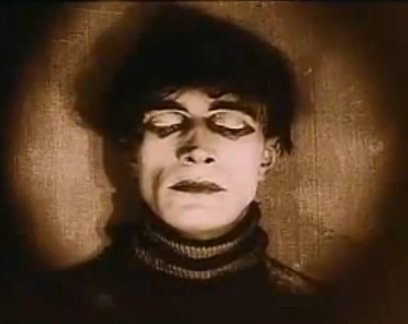
Conrad Veidt set a new standard for monster performance in Caligari. Wegener retained the other-worldliness with his Golem but added an unexpected layer of humanity. And two years later, Max Schreck would strip the monster/vampire of all humanity—making him into a contagion of evil—in Nosferatu. Together, these three make a grand triumvirate of German expressionist horror at its greatest.
This article originally appeared in the blog 21 Essays, as part of the series 21 Days of Golem.
Lee Price is the Director of Development at the Conservation Center for Art and Historic Artifacts, a contributor to Horror 101: The A-List of Horror Films and Monster Movies, and editor of two recently concluded limited-duration blogs, “June and Art” and “Preserving a Family Collection.”

